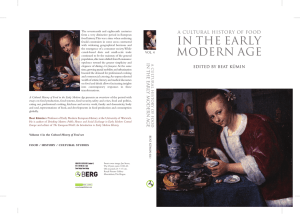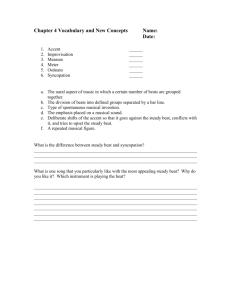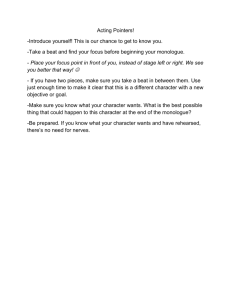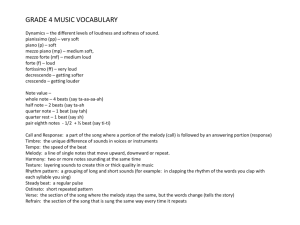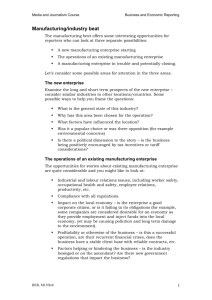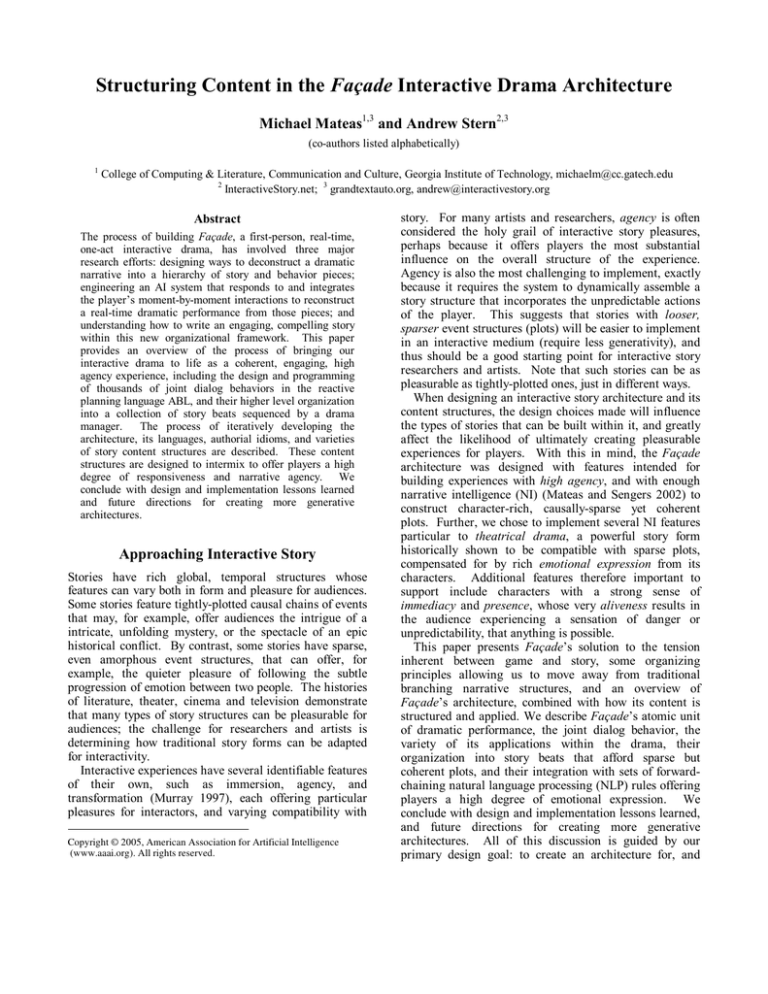
Structuring Content in the Façade Interactive Drama Architecture
Michael Mateas1,3 and Andrew Stern2,3
(co-authors listed alphabetically)
1
College of Computing & Literature, Communication and Culture, Georgia Institute of Technology, michaelm@cc.gatech.edu
2
InteractiveStory.net; 3 grandtextauto.org, andrew@interactivestory.org
Abstract
The process of building Façade, a first-person, real-time,
one-act interactive drama, has involved three major
research efforts: designing ways to deconstruct a dramatic
narrative into a hierarchy of story and behavior pieces;
engineering an AI system that responds to and integrates
the player’s moment-by-moment interactions to reconstruct
a real-time dramatic performance from those pieces; and
understanding how to write an engaging, compelling story
within this new organizational framework. This paper
provides an overview of the process of bringing our
interactive drama to life as a coherent, engaging, high
agency experience, including the design and programming
of thousands of joint dialog behaviors in the reactive
planning language ABL, and their higher level organization
into a collection of story beats sequenced by a drama
manager.
The process of iteratively developing the
architecture, its languages, authorial idioms, and varieties
of story content structures are described. These content
structures are designed to intermix to offer players a high
degree of responsiveness and narrative agency. We
conclude with design and implementation lessons learned
and future directions for creating more generative
architectures.
Approaching Interactive Story
Stories have rich global, temporal structures whose
features can vary both in form and pleasure for audiences.
Some stories feature tightly-plotted causal chains of events
that may, for example, offer audiences the intrigue of a
intricate, unfolding mystery, or the spectacle of an epic
historical conflict. By contrast, some stories have sparse,
even amorphous event structures, that can offer, for
example, the quieter pleasure of following the subtle
progression of emotion between two people. The histories
of literature, theater, cinema and television demonstrate
that many types of story structures can be pleasurable for
audiences; the challenge for researchers and artists is
determining how traditional story forms can be adapted
for interactivity.
Interactive experiences have several identifiable features
of their own, such as immersion, agency, and
transformation (Murray 1997), each offering particular
pleasures for interactors, and varying compatibility with
Copyright © 2005, American Association for Artificial Intelligence
(www.aaai.org). All rights reserved.
story. For many artists and researchers, agency is often
considered the holy grail of interactive story pleasures,
perhaps because it offers players the most substantial
influence on the overall structure of the experience.
Agency is also the most challenging to implement, exactly
because it requires the system to dynamically assemble a
story structure that incorporates the unpredictable actions
of the player. This suggests that stories with looser,
sparser event structures (plots) will be easier to implement
in an interactive medium (require less generativity), and
thus should be a good starting point for interactive story
researchers and artists. Note that such stories can be as
pleasurable as tightly-plotted ones, just in different ways.
When designing an interactive story architecture and its
content structures, the design choices made will influence
the types of stories that can be built within it, and greatly
affect the likelihood of ultimately creating pleasurable
experiences for players. With this in mind, the Façade
architecture was designed with features intended for
building experiences with high agency, and with enough
narrative intelligence (NI) (Mateas and Sengers 2002) to
construct character-rich, causally-sparse yet coherent
plots. Further, we chose to implement several NI features
particular to theatrical drama, a powerful story form
historically shown to be compatible with sparse plots,
compensated for by rich emotional expression from its
characters. Additional features therefore important to
support include characters with a strong sense of
immediacy and presence, whose very aliveness results in
the audience experiencing a sensation of danger or
unpredictability, that anything is possible.
This paper presents Façade’s solution to the tension
inherent between game and story, some organizing
principles allowing us to move away from traditional
branching narrative structures, and an overview of
Façade’s architecture, combined with how its content is
structured and applied. We describe Façade’s atomic unit
of dramatic performance, the joint dialog behavior, the
variety of its applications within the drama, their
organization into story beats that afford sparse but
coherent plots, and their integration with sets of forwardchaining natural language processing (NLP) rules offering
players a high degree of emotional expression. We
conclude with design and implementation lessons learned,
and future directions for creating more generative
architectures. All of this discussion is guided by our
primary design goal: to create an architecture for, and
working example of, high agency, emotionally expressive
interactive drama.
Resolving Game Versus Story
Today’s most pleasurable high agency interactive
experiences are games, because the mechanics of game
agency
are
well
understood
and
reasonably
straightforward to implement. Player moves such as
running, jumping or shooting, playing a card, or moving a
pawn directly cause scores, stats, levels or abstract gamepiece configurations to change. (Simulations of physical
environments and resource-bound systems have more
complex state, but can still be represented numerically in
understood ways.) However, to date, a high agency
interactive story has yet to be built. Existing game design
and technology approaches, that focus on the feedback
loop between player interaction and relatively simple
numeric state, seem inappropriate for modeling the
player’s effect on story structure, whose complex global
constraints seem much richer than can be captured by a set
of numeric counters or game pieces.
Our solution to this long-time conundrum is to recast
interactions within a story world in terms of abstract
social games. At a high level, these games are organized
around a numeric “score”, such as the affinity between a
character and the player. However, unlike traditional
games in which there is a fairly direct connection between
player interaction (e.g. pushing a button to fire a gun) and
score state (e.g. a decrease in the health of a monster), in
our social games several levels of abstraction may separate
atomic player interactions from changes in social “score”.
Instead of jumping over obstacles or firing a gun, in
Façade players fire off a variety of discourse acts, in
natural language, such as praise, criticism, flirtation and
provocation. While these discourse acts will generate
immediate reactions from the characters, it may take
story-context-specific patterns of discourse acts to
influence the social game score. Further, the score is not
directly communicated to the player via numbers or
sliders, but rather via enriched, theatrically dramatic
performance.
As a friend invited over for drinks at a make-or-break
moment in the collapsing marriage of the protagonists
Grace and Trip, the player unwittingly becomes an
antagonist of sorts, forced by Grace and Trip into playing
psychological “head games” with them (Berne 1964).
During the first part of the story, Grace and Trip interpret
all of the player’s discourse acts in terms of a zero-sum
affinity game that determines whose side Trip and Grace
currently believe the player to be on. Simultaneously, the
hot-button game is occurring, in which the player can
trigger incendiary topics such as sex or divorce,
progressing through tiers to gain more character and
backstory information, and if pushed too far on a topic,
affinity reversals. The second part of the story is organized
around the therapy game, where the player is
(purposefully or not) potentially increasing each
characters’ degree of self-realization about their own
problems, represented internally as a series of counters.
Additionally, the system keeps track of the overall story
tension level, which is affected by player moves in the
various social games. Every change in each game’s state
is performed by Grace and Trip in emotionally expressive,
dramatic ways. On the whole, because their attitudes,
levels of self-awareness, and overall tension are regularly
progressing, the experience takes on the form and
aesthetic of a loosely-plotted domestic drama.
Figure1. Grace and Trip in Façade, viewed from the
player's first-person perspective.
Richness Through Coherent Intermixing
Even with a design solution in hand for resolving the
tension between game and story, an organizing principle
is required to break away from the constraints of
traditional branching narrative structures, to avoid the
combinatorial explosion that occurs with complex causal
event chains (Crawford 1989). Our approach to this in
Façade is twofold: first, we divide the narrative into
multiple fronts of progression, often causally independent,
only occasionally interdependent. Second, we build a
variety of narrative sequencers to sequence these multiple
narrative progressions. These sequencers operate in
parallel and can coherently intermix their performances
with one another.
Façade's architecture and content structure are two
sides of the same coin, and will be described in tandem;
along the way we will describe how the coherent
intermixing is achieved.
Architecture and Content Structure
The Façade architecture consists of characters written in
the reactive-planning language ABL, a drama manager
that sequences dramatic beats, a forward-chaining rule
system for understanding and interpreting natural
language and gestural input from the player, and an
animation engine that performs real-time nonphotorealistic rendering, spoken dialog, music and sound,
driven by and providing sensing data to the ABL
behaviors (Mateas & Stern 2004a; Mateas & Stern 2004b;
Mateas & Stern 2003a; Mateas & Stern 2003b; Mateas &
Stern 2000).
The narrative sequencers for the social games are
written in ABL, often taking advantage of ABL’s support
for reflection in the form of meta-behaviors that can
modify the runtime state of other behaviors. The highest
level narrative sequencer, the drama manager, sequences
dramatic beats which are described in a custom drama
management language.
Beats, Beat Goals and Beat Mix-ins
Façade’s primary narrative sequencing occurs within a
beat, inspired by the smallest unit of dramatic action in
the theory of dramatic writing (McKee 1997); however
Façade beats ended up being larger structures than the
canonical beats of dramatic writing. A Façade beat is
comprised of anywhere from 10 to 100 joint dialog
behaviors (jdbs), written in ABL. Each beat is in turn a
narrative sequencer, responsible for sequencing a subset of
its jdb’s in response to player interaction. Only one beat is
active at any time. A jdb, Façade’s atomic unit of
dramatic action (and closer to the canonical beat of
dramatic writing) consists of a tightly coordinated,
dramatic exchange of 1 to 5 lines of dialog between Grace
and Trip, typically lasting a few seconds. Jdbs consist of
40 to 200 lines of ABL code. A beat’s jdbs are organized
around a common narrative goal, such as a brief conflict
about a topic, like Grace’s obsession with redecorating, or
the revelation of an important secret, like Trip’s attempt to
force Grace to enjoy their second honeymoon in Italy.
Each jdb is capable of changing one or more values of
story state, such as the affinity game’s spectrum value, or
any of the therapy game’s self-revelation progression
counters, or the overall story tension level. In the first part
of the story, the within-beat narrative sequencer
implements the affinity game; the topic of the beat is
organized as an instance of the affinity game.
There are two typical uses of jdbs within beats: as beat
goals and beat mix-ins. A beat consists of a canonical
sequence of narrative goals called beat goals. The typical
canonical sequence consists of a transition-in goal that
provides a narrative transition into the beat (e.g. bringing
up a new topic, perhaps connecting it to the previous
topic), several body goals that accomplish the beat (in
affinity game beats, the body goals establish topic-specific
conflicts between Grace and Trip that force the player to
choose sides), a wait goal in which Grace and Trip wait
for the player to respond to the head game established by
the beat, and a default transition-out that transitions out of
the beat in the event of no player interaction. In general,
transition-out goals both reveal information and
communicate how the player’s action within the beat has
changed the affinity dynamic.
The canonical beat goal sequence captures how the beat
would play out in the absence of interaction. In addition to
the beat goals, there are a set of handler meta-behaviors
that wait for specific NLP interpretations of player
discourse acts, and modify the canonical sequence in
response, typically using beat mix-ins. That is, the handler
logic implements the custom narrative sequencer for the
beat. Beat mix-in jdbs are beat-specific reactions used to
respond to player actions and connect the interaction back
to the canonical sequence. Handlers are responsible both
for potentially adding, removing and re-ordering future
beat goals, as well as interjecting beat mix-ins into the
canonical sequence. By factoring the narrative sequencing
logic and the beat goals in this way, we avoid having to
manually unwind the sequencing logic into the beat goal
jdbs themselves.
For Façade, an experience that lasts ~20 minutes and
requires several replays to see all of the content available
(any one runthrough performs at most 25% of the total
content
available),
we authored ~2500 jdbs.
Approximately 66% of those 2500 are in beat goals and
beat mix-ins, organized into 27 distinct beats, of which
~15 are encountered by the player in any one runthrough
(see the drama management section further below).
Global Mix-in Progressions
Another type of narrative sequencer, that operates in
parallel to and can intermix with beat goals and beat mixins, are global mix-ins. (How coherent intermixing is
achieved is described in a later section.) Each category of
global mix-in has three tiers, progressively digging deeper
into a topic; advancement of tiers is caused by player
interaction, such as referring to the topic. Each tier in the
progression is constructed from one or more jdbs, just like
beat goals or beat mix-ins. They are focused on satellite
topics such as marriage, divorce, sex, therapy, or about
objects such as the furniture, drinks, their wedding photo,
the brass bull, or the view, or as generic reactions to
praise, criticism, flirtations, oppositions and the like.
Additionally, there are a variety of generic deflection and
recovery global mix-ins for responding to overly confusing
or inappropriate input from the player. In total there are
~20 instances of this type of narrative sequencer in
Façade, comprising about 33% of the total ~2500 jdbs.
Drama Management (Beat Sequencing)
The coarsest narrative sequencing in Façade occurs in the
drama manager, or beat sequencer. This lies dormant
PlayerArrives, TripGreetsPlayer, PlayerEntersTripGetsGrace,
GraceGreetsPlayer, ArgueOverRedecorating, ExplainDatingAnniversary, ArgueOverItalyVacation, FixDrinksArgument,
PhoneCallFromParents, TransitionToTension2, GraceStormsToKitchen, PlayerFollowsGraceToKitchen, GraceReturnsFromKitchen, TripStormsToKitchen, PlayerFollowsTripToKitchen, TripReturnsFromKitchen, TripReenactsProposal,
BigBlowupCrisis, PostCrisis, TherapyGame, RevelationsBuildup,
Revelations,
EndingNoRevelations, EndingSelfRevelationsOnly,
EndingRelationshipRevelationsOnly,
EndingBothNotFullySelfAware, EndingBothSelfAware
Table 1. The names of Façade’s 27 beats.
most of the time, only active when the current beat is
finished or is aborted (by the beat’s own decision, or by a
global mix-in). It is at the beat sequencing level where
causal dependence between major events is handled – that
is, where high-level plot decisions are made.
In a beat sequencing language the author annotates each
beat with selection knowledge consisting of preconditions,
weights, weight tests, priorities, priority tests, and story
value effects – the overall tension level, in Façade’s case.
Given a collection of beats represented in the beat
language, such as the 27 listed in Table 1, the beat
sequencer selects the next beat to be performed. The
unused beat whose preconditions are satisfied and whose
story tension effects most closely match the near-term
trajectory of an author-specified story tension arc (in
Façade, an Aristotelian tension arc) is the one chosen;
weights and priorities also influence the decision. (Mateas
& Stern 2003a)
Subsequent sections on Context Intermixing and
Failures and Successes further discuss beat sequencing.
Long-term Autonomous Mix-in Behaviors
Long-term autonomous behaviors, such as fixing drinks
and sipping them over time, or carrying around and
compulsively playing with an advice ball toy, last longer
than a 60-second beat or a 10-second global mix-in.
While perhaps performing only a minor narrative
function, occasionally mixing in a jdb into the current beat
(comprising only 1% of Façade’s jdbs), they contribute a
great deal to the appearance of intelligence in the
characters, by having them perform extended, coherent
series of low-level actions in the background over the
course of many minutes, across several beat boundaries.
By simultaneously performing completely autonomous
behaviors and joint behaviors, Façade characters are a
hybrid between the “one-mind” and “many-mind”
extremes of approaches to agent coordination, becoming
in effect “multi-mind” agents (Mateas & Stern 2004a).
Strategies for Coherent Intermixing
Since global mix-ins for the hot-button game are
sequenced among beat goals/mix-ins for the affinity game,
which both operate in parallel with the drama manager
that is occasionally progressing overall story tension,
several strategies are needed to maintain coherency, both
in terms of discourse management and narrative flow.
First, global mix-in progressions are written to be
causally independent of any beats’ narrative flow. For
example, while quibbling about their second honeymoon
in Italy, or arguing about what type of drinks Trip should
serve (affinity game beats, chosen by the drama manager),
it is safe to mix in dialog about, for example, sex, or the
wedding photo (hot-button game mix-ins, triggered by a
player’s reference to their topics). Each mix-in’s dialog is
written and voice-acted as if they are slightly tangential
topics that are being jutted into the flow of conversation
(“Oh, that photo, yeah, it’s really...”).
At the discourse level, mechanisms exist for smoothly
handling such interruptions. During a beat goal, such as
Trip’s reminiscing about the food in Italy, if a global mixin is triggered, such as the player picking up (referring to)
the brass bull (a gift from Trip’s lover), the current Italy
beat goal will immediately stop mid-performance, and the
brass bull global mix-in will begin performing, at
whichever tier that hot-button game has already
progressed to. At the time of interruption, if the Italy beat
goal had not yet passed its gist point, which is an authordetermined point in a beat goal’s jdbs, it will need to be
repeated when the global mix-in completes. Short,
alternate uninterruptible dialog is authored for each beat
goal for that purpose. Also, each beat goal has a
reestablish jdb that gets performed if returning to the beat
from a global mix-in (“So, I was going to say, about
Italy...”). Mix-in’s themselves can be interrupted by other
mix-in’s, but if so, are not repeated as beat goals are.
With only a few exceptions, the narratives of affinity
game beats themselves are also designed to be causally
independent of one another, relating to the “sparse plot”
characterization made earlier. For example, it does not
matter which order Grace and Trip argue about Italy, their
parents, redecorating, fixing drinks, or their dating
anniversary. When beat sequencing, this allows the
drama manager to prefer sequencing any beats related to
past topics brought up by the player. Likewise, hot-button
mix-ins can be safely triggered in any order, into almost
any beat at any time.
However, great authorial effort was taken to make the
tone of each beat goal/mix-in and global mix-in match
each other during performance. Most jdbs are authored
with 3 to 5 alternates for expressing its narrative content
at different combinations of player affinity and tension
level. These include variations in word choice, voiceacting, emotion, gesture, and appropriate variation of
information revealed. By having the tone of hot-button
global mix-ins and affinity game beat goals/mix-ins
always match each other, players often perceive them as
causally related, even though they are not. Additionally,
for any one tone, most jdbs are authored with 2 to 4 dialog
alternates, equivalent in narrative functionality but
helping create a sense of freshness and non-roboticness in
the characters between runthroughs of the drama.
Evaluating Agency
The structure of narrative content in Façade, described in
the previous sections, is intended to afford high agency for
players, a primary pleasure of interactive experiences. In
this section we identify two types of agency: local and
global, and attempt to evaluate the degree of their
existence in Façade.
Local Agency
When the player’s actions cause immediate, contextspecific, meaningful reactions from the system, we call
this local agency. Furthermore, the greater the range of
actions the player can take, that is, the more expressive the
interface, then the richer the local agency (again, if the
responses are meaningful).
Façade offers players a continuous, open-ended natural
language interface, as well as physical actions and
gestures such as navigation, picking up objects, hugging
and kissing. The millions of potential player inputs are
mapped, using hundreds of authored forward-chaining
NLU rules, into one or more of ~30 parameterized
discourse acts (DA’s) such as praise, exclamation, topic
references, and explanations. Another set of rules called
context proposers then interpret these DA’s in contextspecific ways, such as agreement, disagreement, alliance,
or provocation (Mateas and Stern 2004b).
Ideally there would be immediate, meaningful, contextspecific responses available at all times for all DA’s. In
the actual implementation of Façade, in our estimation
this ideal is reached ~25% of the time, where the player
has a satisfying degree of real-time control over Grace and
Trip’s emotional state, affinity to the player, which topic is
being debated, what information is being revealed, and the
current tension level. But more often, ~40% of the time,
only a partial ideal is reached: the mapping/interpretation
from DA to reaction is coarser, the responses are more
generic and/or not as immediate. Furthermore, ~25% of
the time even shallower reactivity occurs, and ~10% of the
time there is little or no reactivity. These varying levels of
local agency are sometimes grouped together in temporal
clusters, but also have the potential to shift on a momentby-moment basis.
There are two main reasons for these varying levels of
local agency. First, from a design perspective, at certain
points in the overall experience it becomes necessary to
funnel the potential directions of the narrative in
authorially preferred directions, to ensure dramatic pacing
and progress. Second, and more often the case, a lack of
local agency is due to limitations in how much narrative
content was authored (see the Failures section below).
Global Agency
The player has global agency when the global shape of the
experience is determined by player action. In Façade this
would mean that the final ending of the story, and the
particulars of the narrative arc that lead to that ending, are
determined in a smooth and continuous fashion by what
the player does, and that at the end of the experience the
player can understand how her actions led to this
storyline.
Façade attempts to achieve global agency in a few
ways. First, beat sequencing (i.e., high level plot) can be
influenced by what topics the player refers to; the
sequencing can vary within the number of allowed
permutations of the beats’ preconditions and tension-arcmatching requirements. Even with only 27 beats in the
system, technically there are thousands of different beat
sequences possible; however, since most beats are causally
independent, the number of meaningfully different beat
sequences are few.
More significant than variations of beat sequences
(“what” happened) are variations within beats and global
mix-in progressions (“how” it happened). A variety of
patterns and dynamics are possible within the affinity, hotbutton and therapy games over the course of the
experience; in fact these patterns are monitored by the
system and remarked upon in dramatic recapitulations in
the BigBlowupCrisis beat halfway through the drama, and
in the RevelationsBuildup beat at the climax of the drama.
A calculus of the final “scores” of the various social games
is used to determine which of five ending beats gets
sequenced, ranging from either Grace or Trip revealing
one or more big hidden secrets and then deciding to break
up and leave, or both of them too afraid to do anything, or
both them realizing so much about themselves and each
other that they decide to stay together.
Failures and Successes
During the production of Façade, within our “limited”
authoring effort (beyond the building of the architecture,
Façade required ~3 person years of just authoring, which
is more than a typical art/research project but far less than
a typical game industry project) we made the tradeoff to
support a significant degree of local agency, which in the
end came at the expense of global agency. Combined with
the reality that the time required to design and author jdbs
is substantial, only 27 beats were created in the end,
resulting is far lower global agency than we initially hoped
for. As a result, we feel we did not take full advantage of
the power of the drama manager’s capabilities.
Furthermore, because the specification of each joint
dialog behavior – spoken dialog, staging directions,
emotion and gesture performance – requires a great deal
of authoring and is not automatically generated by higherlevel behaviors or authoring tools, we are limited to the
permutations of hand-authored, intermixable content.
Façade is not generating sentences – although it is
generating sequences.
A major challenge we encountered, that we believe
Façade falls short on, is always clearly communicating the
state of the social games to the player. With traditional
games, it is straightforward to tell players the game state:
display a numeric score, or show the character physically
at a higher platform, or display the current arrangement of
game pieces.
But when the “game” is ostensibly
happening inside of the characters’ heads, and if we
intend to maintain a theatrical, performative aesthetic
(and not display internal feelings via stats and slider bars,
ala The Sims), it becomes a significant challenge. In our
estimation Façade succeeds better at communicating the
state of the simpler affinity and hot-button games than the
more complex therapy game.
Another major challenge was managing the player’s
expectations, raised by the existence of an open-ended
natural language interface.
We anticipated natural
language understanding failures, which in informal
evaluations of Façade to date, occur ~30% of the time on
average. This tradeoff was intentional, since we wanted to
better understand the new pleasures that natural language
can offer when it succeeds, which in Façade we found
occurs ~70% of the time, either partially or fully.
In our estimation, a success of Façade is the integration
of the beat goal/mix-in, global mix-in and drama manager
narrative sequencers, with an expressive natural language
interface, context-specific natural language processing,
and expressive real-time rendered character animation.
We feel the overall effect makes some progress towards
our original design goals of creating a sense of the
immediacy, presence, and aliveness in the characters
required for theatrical drama.
Certain aspects of our drama’s design help make
Façade a pleasurable interactive experience, while others
hurt. It helps to have two tightly-coordinated non-player
characters who can believably keep dramatic action
happening, in the event that the player stops interacting or
acts uncooperatively. In fact, the fast pace of Grace and
Trip’s dialog performance discourages lengthy natural
language inputs from the player. By design, Grace and
Trip are self-absorbed, allowing them to occasionally
believably ignore unrecognized or unhandleable player
actions. Creating a loose, sparsely plotted story afforded
greater local agency, but provided fewer opportunities for
global agency. However, the richness of content variation,
and at least moderate degree of global agency achieved,
does encourage replay.
The huge domain of the drama, a marriage falling
apart, arguably hurt the success of the overall experience,
in that it overly raised players’ expectations of the
characters’ intelligence, psychological complexity, and
language competence. As expected, the system cannot
understand, nor has authored reactions for, many
reasonable player utterances. The large domain often
requires mapping millions of potential surface texts to just
a few discourse acts, which can feel muddy or overly
coarse to the player.
Also, continuous real-time
interaction, versus discrete (turn-taking) and/or non-realtime interaction, added a great deal of additional
complexity and authoring burden.
Future Directions
In order to relieve the high authoring burden encountered
in building Façade, particularly in writing the thousands
of joint dialog behaviors required for an interactive drama
with significant player agency, an even more generative
approach is required. One approach is to create a higherlevel authoring tool, which compiles a more abstract
specification of narrative behavior into a set of
corresponding joint dialog ABL behaviors. Greater
authoring productivity would allow for increased local and
global agency, since higher numbers of performance
behaviors could be created more quickly and efficiently.
Such an authoring tool would substantially increase the
possibility for artists with minimal programming skills to
help build high agency interactive dramas. Short of that,
developers with significant aptitude and experience in
programming, dramatic writing and game design will be
required, of which there are currently few, and few
educational curricula to create them.
Additional approaches include implementing more lowlevel support for managing and generating emotion-rich,
dramatic conversation behaviors, such as integrating the
Em emotion bookkeeping system (Reilly 1997), automated
non-verbal conversation gestures (Vilhjálmsson 2003), or
procedural body animation (Perlin 2004).
References
Berne, E. 1964. Games People Play. New York: Grove Press.
Crawford, C. 1989. Indirection. Journal of Computer Game
Design, Volume 3. http://www.erasmatazz.com/library/JCGD_
Volume_3/JCGD_Volume_3_Index.html
Mateas, M. and Sengers, P. (Eds.). 2002. Narrative Intelligence.
Amsterdam: John Benjamins.
Mateas, M. and Stern, A. 2004a. A Behavior Language: Joint
Action and Behavioral Idioms. In Predinger, H. and Ishiuka, M.
(Eds), Life-like Characters: Tools, Affective Functions and
Applications, Springer 2004.
Mateas, M. and Stern, A. 2004b. Natural Language
Understanding in Façade: Surface Text Processing. In
Proceedings of Technologies for Interactive Digital Storytelling
and Entertainment, Darmstadt, Germany, June 2004.
Mateas, M. and Stern, A. 2003a. Integrating plot, character and
natural language processing in the interactive drama Façade. In
1st International Conference on Technologies for Interactive
Digital Storytelling and Entertainment (TIDSE ’03), Darmstadt,
Germany , March 24 – 26, 2003 .
Mateas, M. and Stern, A. 2003b. Façade: an experiment in
building a fully-realized interactive drama, Game Developers
Conference (GDC ’03), San Jose, CA, USA, March 4 – 8, 2003.
Mateas, M. and Stern, A. 2000. Towards Integrating Plot and
Character for Interactive Drama. In Working notes of the Social
Intelligent Agents: The Human in the Loop Symposium. AAAI
Fall Symposium Series. Menlo Park, CA.: AAAI Press.
McKee, R. 1997. Story: Substance, Structure, Style, and the
Principles of Screenwriting. New York: HarperCollins.
Murray, J. 1997. Hamlet on the Holodeck. New York: Free
Press. 1998, Cambridge, MA: MIT Press.
Perlin, K. 2004. Emotive Actors. Media Research Laboratory,
NYU. http://mrl.nyu.edu/~perlin/experiments/emotive-actors
Reilly, S. 1997. Believable Social and Emotional Agents. Ph.D.
thesis, Tech report CMU-CS-96-138, Carnegie Mellon
University.
Vilhjálmsson, H. 2003. Avatar Augmented Online Conversation.
Ph.D. thesis, MIT Media Lab.

